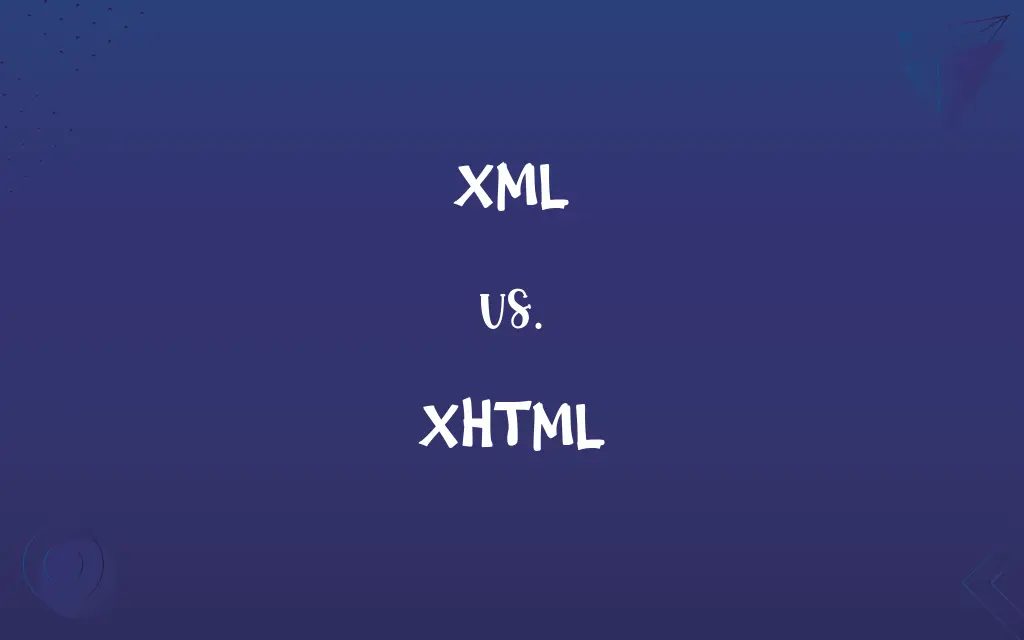XML vs. XHTML: Know the Difference

By Shumaila Saeed || Published on February 24, 2024
XML is a flexible markup language for structured data, while XHTML is a stricter and cleaner reformulation of HTML in XML format.

Key Differences
XML, or Extensible Markup Language, is a flexible text format derived from SGML, primarily used to store and transport data. It allows users to define their own tags, making it highly customizable. XHTML, on the other hand, is a specific application of XML, standing for Extensible Hypertext Markup Language. It is essentially a stricter and cleaner version of HTML, designed to adhere to XML standards.
Shumaila Saeed
Feb 24, 2024
The design of XML is focused on simplicity, generality, and usability across the Internet. It is used in a wide variety of applications, such as web services, document storage, and configuration files, due to its flexibility in defining custom data structures. XHTML, in contrast, is specifically aimed at web documents. It demands more rigorous syntax and document structure compared to traditional HTML, ensuring that documents are well-formed and easily processed by XML parsers.
Shumaila Saeed
Feb 24, 2024
In XML, there is no predefined tag set; users define their own tags and document structure to suit their specific needs. This makes XML incredibly versatile and adaptable for various data representation needs. XHTML, however, uses a specific set of tags defined by the W3C, which are consistent with HTML but follow the stricter syntax rules of XML. This ensures compatibility with a wide range of web browsers and devices.
Shumaila Saeed
Feb 24, 2024
XML is primarily a data carrier and not concerned with how data looks. It is often used in combination with other technologies, like XSLT, to process and present the data. XHTML, being a web markup language, is intrinsically concerned with presentation and layout of web content, integrating seamlessly with CSS and JavaScript for styling and interactivity.
Shumaila Saeed
Feb 24, 2024
XML documents can be designed to be self-descriptive, making the data easy to understand and process. It’s often used for data exchange between incompatible systems or platforms. XHTML documents, while also being self-descriptive, must adhere to stricter standards of web compatibility, focusing on displaying content in a consistent manner across different web browsers.
Shumaila Saeed
Feb 24, 2024
ADVERTISEMENT
Comparison Chart
Purpose
General data representation and storage
Structuring and presenting web content
Shumaila Saeed
Feb 24, 2024
Main Use
Data exchange, configuration files, web services
Web pages, ensuring cross-browser compatibility
Shumaila Saeed
Feb 24, 2024
Integration with Other Technologies
Often used with XSLT, XPath
Integrates with CSS, JavaScript
Shumaila Saeed
Feb 24, 2024
ADVERTISEMENT
XML and XHTML Definitions
XML
XML allows users to define their own tags, making it highly versatile for data representation.
To represent our product data, we created a custom XML schema.
Shumaila Saeed
Jan 17, 2024
XHTML
XHTML is a reformulation of HTML in XML, combining the strengths of both HTML and XML.
Our website's pages are written in XHTML for greater consistency and compliance.
Shumaila Saeed
Jan 17, 2024
XML
XML is platform-independent and well-suited for data exchange between disparate systems.
We use XML to transfer data between our internal systems and external partners.
Shumaila Saeed
Jan 17, 2024
XHTML
XHTML promotes cleaner and more organized code, enhancing maintainability and readability.
Refactoring our site to XHTML improved the clarity and structure of our codebase.
Shumaila Saeed
Jan 17, 2024
XML
XML focuses on the structure and transport of data, rather than its presentation.
The API returns the response in XML format which is then styled using XSLT.
Shumaila Saeed
Jan 17, 2024
ADVERTISEMENT
XHTML
XHTML requires strict adherence to XML syntax, ensuring well-formed and valid documents.
The XHTML document was validated to ensure it met strict XML standards.
Shumaila Saeed
Jan 17, 2024
XML
XML is a markup language for encoding documents in a format that is both human-readable and machine-readable.
The configuration settings were stored in an XML file.
Shumaila Saeed
Jan 17, 2024
XHTML
XHTML supports integration with other web technologies like CSS and JavaScript.
We styled the XHTML content with CSS for a responsive design.
Shumaila Saeed
Jan 17, 2024
XML
XML serves as a foundation for many web technologies, including XHTML and SOAP.
SOAP, a protocol for web services, utilizes XML for its message format.
Shumaila Saeed
Jan 17, 2024
XHTML
XHTML is designed to be more predictable and compatible across different web browsers.
Using XHTML helps avoid rendering issues in various browsers.
Shumaila Saeed
Jan 17, 2024
XML
An international standard metalanguage for creating markup languages that structure digital information in a way that allows for the exchange, display, and storage of data independent of proprietary operating systems and hardware devices.
Shumaila Saeed
Jan 17, 2024
Repeatedly Asked Queries
What is XML?
XML is a flexible markup language used for data representation and exchange.
Shumaila Saeed
Feb 24, 2024
How does XML differ from HTML?
XML focuses on data structure and transport, while HTML is about presenting web content.
Shumaila Saeed
Feb 24, 2024
Can XML be used for web pages?
XML itself isn't used for web pages, but it can be transformed for web use with XSLT.
Shumaila Saeed
Feb 24, 2024
Is XHTML compatible with all web browsers?
Yes, XHTML is designed for compatibility across various web browsers.
Shumaila Saeed
Feb 24, 2024
Does XHTML support CSS and JavaScript?
Yes, XHTML works well with CSS and JavaScript for styling and functionality.
Shumaila Saeed
Feb 24, 2024
Why use XHTML instead of HTML?
XHTML offers greater predictability and stricter syntax, reducing errors and improving compatibility.
Shumaila Saeed
Feb 24, 2024
What is a well-formed XML document?
A well-formed XML document correctly follows XML syntax rules.
Shumaila Saeed
Feb 24, 2024
Does XHTML require closing tags?
Yes, XHTML requires all tags to be properly closed.
Shumaila Saeed
Feb 24, 2024
How does XHTML handle errors differently than HTML?
XHTML is stricter; malformed documents may not render at all.
Shumaila Saeed
Feb 24, 2024
What does it mean that XHTML is an application of XML?
XHTML is a specific use-case of XML, applying its syntax to web document structure.
Shumaila Saeed
Feb 24, 2024
Is XML platform-independent?
Yes, XML is designed to be platform- and language-independent.
Shumaila Saeed
Feb 24, 2024
Is XML human-readable?
Yes, XML is both human-readable and machine-readable.
Shumaila Saeed
Feb 24, 2024
What are XML Schemas?
XML Schemas define the structure and rules for XML documents.
Shumaila Saeed
Feb 24, 2024
Is XHTML still relevant with HTML5?
XHTML is less common now, but still relevant for specific needs, especially where stricter syntax is desired.
Shumaila Saeed
Feb 24, 2024
Can XHTML be served as HTML?
Yes, XHTML can be served as HTML if sent with the appropriate MIME type.
Shumaila Saeed
Feb 24, 2024
Can XML be used for data storage?
Yes, XML is often used for storing structured data.
Shumaila Saeed
Feb 24, 2024
How do XHTML and HTML5 differ?
HTML5 is more flexible and less strict than XHTML.
Shumaila Saeed
Feb 24, 2024
Can XML be used in web services?
Yes, XML is widely used in web services for data exchange.
Shumaila Saeed
Feb 24, 2024
Share this page
Link for your blog / website
HTML
Link to share via messenger
About Author
Written by
Shumaila SaeedShumaila Saeed, an expert content creator with 6 years of experience, specializes in distilling complex topics into easily digestible comparisons, shining a light on the nuances that both inform and educate readers with clarity and accuracy.









































































